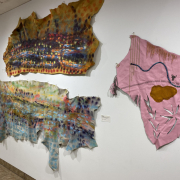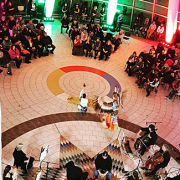2016 Arts Congress Summary
Record Numbers at the 2016 Arts Congress: Into the Future Wild
The 2016 Arts Congress marked 30 years for the Saskatchewan Arts Alliance. To celebrate, the Congress hosted over a hundred local, federal, and international artists, arts administrators, economists, researchers, and much more!
Award-winning hip hop artist Eekwol opened the Congress and engaged the audience with her music and her stories. This performance was sponsored by Sakêwêwak.
Keynote speaker John Holden, discussed the intricacies of how culture works by applying ecological metaphors. He explored the nuances of arts networks citing three spheres: funded, commercial, and homemade; as well as the roles we each take: connectors, platforms, guardians, and nomads.
Joey Tremblay, auteur-director, playwright, theatre-maker, and actor shared his story. Growing up in the shadows of the baby boomers, he feels it is important to communicate with the younger generation and create opportunities for incubation. He related the story of his grandmother, a folk artist, who built a theatre in the barn for seven year old Tremblay and by doing so, supported conditions to make creations happen.
John Holden moderated Friday’s panel Into the Future Wild with Chief Lynn Acoose, Johanna Bundon, Michael Jones, and Janine Windolph. The themes of the panel included emergence, incubation, sustainability, and moving forward:
- Johanna Bundon explored the need to have many projects on the ground in order to succeed and how artists used to make movements and now they make projects? She also noted how good it felt to have “artist” on her nametag.
- Michael Jones admitted he was envious of the name tags with that title, but noted that the role of the institution is still important and integral to a healthy ecology. He admitted that funders grapple with how to fund so many different projects while using a one size fits all model, Jones wonders if the “do no harm” philosophy is the best route especially when there was such panic in the sector when the Canada Council made a radical overhaul of their funding system.
- Chief Lynn Acoose felt the Idea of being nomadic for Indigenous artist is about being a part of a greater movement, many movements, and a social movement. She expressed that the understanding of artists, administrators, etc. comes from a place attached to historical alliances and historical traumas.
- Janine Windolph decided she would become a filmmaker so that she could share the stories she never saw on television growing up in La Ronge. She noted that people wanted to focus on the Indigenous and put her work in a box when she really wanted to work in a circle. She found that by sharing stories it created a kinship of shared experience and feeling despite not getting the closure or the explanation that is often found in main stream films.
Mary Blackstone and Ian McWilliams summarized two years of SPAR’s research focusing on the arts ecology of Saskatchewan – its artists, their work, and their creative networks. The summary included numbers from SPAR’s community consultations and surveys. To find out more about SPAR and its findings, visit their website. As part of the SPAR project, Congress delegates were able to contribute to the ongoing dialogue regarding the Saskatchewan Arts Ecology.
Friday night’s reception brought greetings from Hon. Ralph Goodale and Hon. Mark Docherty, inspiration from the Poet Laureate Gerry Hill (sponsored by the Sask Writers’ Guild) and keynote speaker Tracey Lindberg, and fun from the improv group Red Hot Riot.
Hill read examples of his latest poetry Lindberg read from her book Birdie and shared that she wrote it to represent a point of view that is rarely ever seen in literature. She spoke of advocacy and activism and expressed her views that we are all family and should take care of each other as such – by bringing everyone to the room – by showing up – and by making a positive difference in the community.
Saturday May 7, 2016
The Congress opened on Saturday morning with Coffee with the Provincial Funders: Rose Gilks of SaskCulture, Susan Gorges of Creative Saskatchewan, and Michael Jones of the Saskatchewan Arts Board. Jones reported the upcoming review of SAB funding and a big meeting at the end of May regarding a program review. Gorges clarified that CS is a crown agency – not arms-length – and that half the board is appointed while the other half is nominated.
Shayna Stock, performance poet and spoken word artist, spoke to the reality of a person’s choice – that practicing art is a choice and that it is the surrounding conditions that either makes it easier or harder. She shared the story of her first encounter of the spoken word community in Toronto and how she created a similar community in Regina, which took years. Stock related her feeling that a good audience creates better performers and ended her talk with a poem.
Jennifer Matotek asked how do we argue for the arts – she wondered if we are going in the right direction – how do we argue a consistent story? Instead of arguing art builds the economy, argue that arts impact people’s health, which is a more reflective conversation. Arts in people’s lives have a collective impact and she took the opportunity to thank the advocates who, she feels, are the true collaborators with the best stories.
Simon Brault, CEO and Director of the Canada Council talked with SAA president Kelley Jo Burke about the changes happening to the Council. When asked why the changes, Brault remarked that they would not have received any money without reinventing itself. Over the next five years the Council’s budget will be doubled – $45 million the first year and $35 million every year for four years ongoing with $33.4 million for new projects such as the New Chapter Project and $1.8 million to the {Re}conciliation project. Brault confirmed that 88% of the new money received every year will be spent on artists. Stay tuned to hear Brault’s full conversation with Kelley Jo Burk as we will be posting the podcast on our website.
SAA Board Member Kent Allan moderated the Create, Connect + Catalyze Panel featuring panelists Brad Bellegarde, Osemis Isbister-Bear, and Robin Poitras. Bellegarde spoke of art identity and his emergence into the hip-hop culture. Bellegarde uses hip-hop as a means to connect with youth on social issues. Isbister-Bear shared that he knows arts are a vehicle for Indigenous youth to succeed and that he learned from his father who engaged youth through culture. He acknowledged that the bigger the networks – the more success – and that by using art for reconciliation there is a healing within local and larger communities. Poitras pointed out that by creating opportunities for youth and the general public to engage with the arts like dance, theatre, and hip-hop bridges are built that can last a lifetime.
Lowell Dean shared his experience as a Saskatchewan filmmaker. He admitted that he is consistently unemployed and that his time is 70% brainstorming/writing and 30% directing. Dean works anywhere from 7 – 12 hours a day seven days a week and is constantly debating leaving the province to find more work since 50% of directing work is outside of the province due to the elimination of the Film Employment Tax Credit.
Chrystene Ells gave an overall impression of her life as an artist. She shared how busy she is facilitating community programs, film festivals, and creating puppet works herself. Ells admitted that the life of an artist is not what she imagined because a large chunk of her time is not used creating art but applying for project funding and doing follow-up reports. However such time is worth it because it allows her to engage with other people and create art.
A Conversation on Valuing the Arts was had with SAA board member Marcus Miller, City of Regina Councillor Shawn Fraser, and economist Alan Freeman. Fraser opened the conversation stating that when it comes to culture and society, everyone has a role including government. He continued with his belief that municipal investment in the arts creates a more diverse and attractive city, which entices people to stay within the province and attracts new people bringing new jobs with them. Freeman asserted that the role of art is to disrupt and disturb and that art is meant to be human – the opposite of mechanical. He also made the point that the creative ecology is much larger than just artists and arts administers – it could be argued that the arts ecology includes a variety of people from those in the service industry to the caretakers who clean the toilets.
The 2016 Arts Congress closed with a Talk Back with the SAA Board of Directors. Issues that were brought forward included the need for a strong arts curriculum, the inclusion of young artists at events like the Congress, and the need to change SAA’s mandate to reflect that individual artists can be members of the organizations.
Saskatchewan Arts Alliance thanks 2016 Arts Congress sponsors: Ministry of Parks Culture and Sport, Sakêwêwak, and the Saskatchewan Writers’ Guild. For ongoing support, SAA also thanks SaskCulture and Saskatchewan Lotteries, and the Saskatchewan Arts Board.


